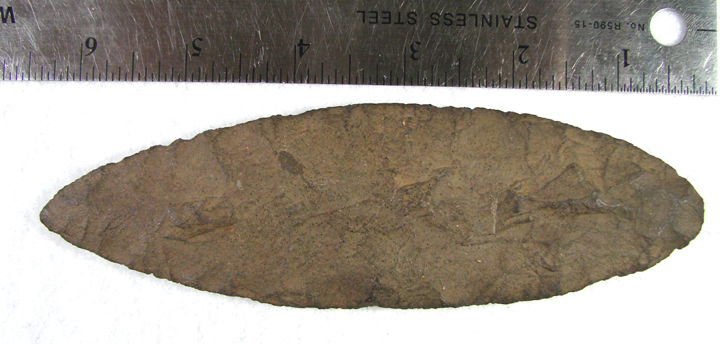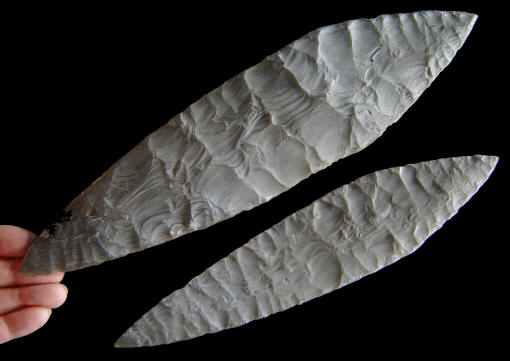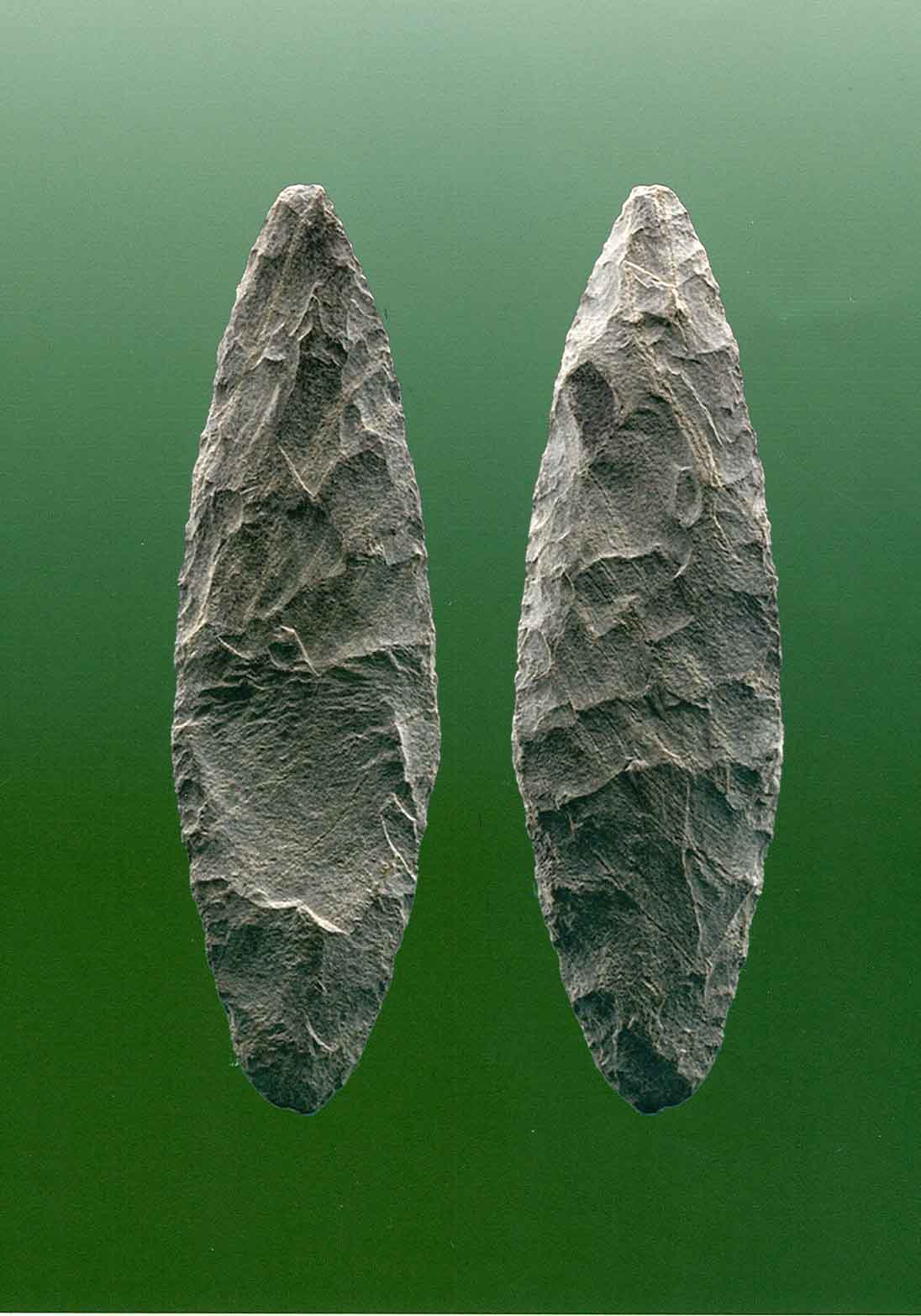You may recall from earlier threads dealing with the Solutrean hypothesis that in 1970 the deep sea scallop trawler named Cinmar dredged up a bi-pointed blade, along with mastodon bones, in 75 meters of water about 100 kilometers off the coast of the Virginia Capes, at the edge of the continental shelf. And you may further recall that Stanford and Bradley, in Across Atlantic Ice, believe the blade and bones are associated, and supportive of the Solutrean hypothesis. They do of course acknowledge that there is no definitive proof the bones and blade are associated. Although there is an illustration of both sides of this blade in Across Atlantic Ice, as well as a cover photo of one side, I recently came across this photo, which is the first I've seen showing both sides. The photo originates from the Gwynns Island Museum, where the blade is displayed. It is most certainly NOT my intention to start another Solutrean thread by posting this photo. I have no control over that, of course, but since the blade has been discussed in previous threads, and because this photo shows both sides and can be enlarged quite a bit(although the resolution is not the very best) I wanted to share it here for anyone interested in seeing it. The material is described as a banded meta-rhyolite. I am posting it simply for the informational value a photo provides. Chase posted a photo of the cover shot awhile back but I believe this is the only one available that shows both sides of this artifact.
Announcement
Collapse
No announcement yet.
The Cinmar Blade
Collapse
This topic is closed.
X
X
-
-
Just for the record, it's not MY biface :laugh: :laugh:
I did say I did not intend this to start another Solutrean thread. But I will note that I think the statement "it cannot be proved so it is not so" is an illogical statement. I believe the best debates on the subject, with logically developed arguments on both sides of the issue, can be found on the old PROS board.
It cannot be proved that there is life elsewhere in the universe, so there cannot be life elsewhere in the universe :huh:
Rhode Island
Comment
-
Hmmmm......according to Overstreet, the Boats Blade ranges from 3000 to 10,000 YBP. So, that is a possibility. Considering where it was found, assuming no-one dropped it off the side of a boat.....I would assume it to be quite old.....having been on the edge of the continental shelf and under 200+ feet of water....which is where the shore was with the lower water levels due to the glaciers. The unanswered question is, is it pre-clovis? The mammoth bones found in the same general area were carbon dated to well before Clovis times....but, it can't be said scientifically that they were in context with eachother. There are many assumptions made, which when looked at collectively (ie: Cinmar blade, Cactus Hill, Meadowcroft, etc)certainly make me admit that pre-clovis is a strong possibility....and that an Atlantic route is as well.
It is a hotly debated issue, I wouldn't say it's BS Jack.....I would say it is very much a possibility as more and more evidence is found.....keeping in mind, that most of the evidence today is under a whole lotta water!.....of course, this is just my opinion.....after all, the world was once flat.....wasn't it?.....eventually, it was proven wrong.
Southern Connecticut
Comment
-
Hi CMD, as one who believes Dr's Stanford and Bradley really have discovered (WOW, they have nailed it!) where Clovis origins came from, I have have to say, don't dismiss the possibility of the existence of Solutrean Laurel Leaf points here.
It follows that if Clovis really did come from the Spanish Solutrean then shortly before deliberate fluting of bifaces began here, Solutrean styled points were used here.
Comment
-
Jack, I'm not seeing much difference at all, however I am seeing different materials. True European flint is among the finest in the world. This superb material allowed the master Solutrean knappers to practice their craft and lift it the artistic levels.
American Chert, and other materials here do not rival European Flint in workability. Here Solutrean knappers did the best with what they had to work with. The hallmark of Solutrean technology was the outre pase bifical thinning strategy of the biface. I see that strategy in the projectile that was dredged up.
Early Clovis fluted points were made using the identical bifacial thining stategy the Solutreans used. To me it is clear that Clovis and Solutrean are directly related.
Comment
-
I don't dismiss it, Bill, but the old adage extraordinary claims require extraordinary proof applies to the Solutrean hypothesis. I am looking foward to the expedition planned for the site of the Cinmar blade find this summer.Bill wrote:
Hi CMD, as one who believes Dr's Stanford and Bradley really have discovered (WOW, they have nailed it!) where Clovis origins came from, I have have to say, don't dismiss the possibility of the existence of Solutrean Laurel Leaf points here.
It follows that if Clovis really did come from the Spanish Solutrean then shortly before deliberate fluting of bifaces began here, Solutrean styled points were used here.
Rhode Island
Comment
-
The Solutrean connection was suggested as far back as the 1950s, by H.M. Wormington, and others. One problem though, as others have pointed out, is this. If the Solutreans made an Atlantic ocean voyage, of course they had boats. Which means they would have made those boats on the eastern shores of Europe. And yet there hasn't been a single, not one, hardstone tool ever found that would have been used to build those boats. They surely would not have built a boat large enough and strong enough to cross an ocean with flint knives and scrapers. Also, IF they made that voyage, after they landed, they would have been hunting, and would have camps, therefore, Soultrean should exist somehwere inland. And yet, there hasn't been a single Solutrean tool found anywhere inland from the coastel areas. Why can't Bradley and Stanford just accept the fact, that they ( the Solutreans )simply did not cross the ocean and land anywhere on the North American continent. There were probably pre-Clovis migrations into America, but they should spend their valuable time looking toward South America, where actual fluted points have been found.
- Likes 1
Comment
-
All this talk about the outre passe flaking technique. Outre passe does not, in itself, prove a blade is Paleo, or older. Many cultures used this techique to thin their blades, including the Perkiomen points, Jacks Reef points, Adena points. I could attach photos of some nice Archaic points with this flaking. Outre passe is a technique, it can't be used to establish antiquity.
Comment
-
I find the claim of Clovis from Solutrean entirely logical and not extraordinary in any way. When Dr. Bradley, who has carefully studied Solutrean technology and tool types and those of Clovis also, says both are identical that is good enough for me.
An extraordinary claim would be for someone to believe that Clovis came from Eastern, Northeastern Asia, or South of the Border. The stone working technology that was required for the development of Clovis never existed outside of the European Solutrean.
That makes two of us.
Comment
-
I don't believe Bradley and Stanford realize all the trouble they caused. The birth of navigation and tne invention of boats is believed to be around 4000 B.C. - 3500 B.C. Now someone has to go back and rewrite all the history and archeological books and include the new dates of boat/ship origins to be ca. 14,000 B.C.
Comment
-
pkfrey, there may be no hard evidence yet that folks of the Spanish Solutrean were boat building seafarers. However absence of evidence is not the evidence of absence because Australia was colonized from Southeastern Asia around 50,000 years ago. This meant immigrants had to cross a 50 mile open stretch of deep water ocean. No boats that old have been found in either place. Yet it must be inferred that boats they used therefore boats they had.
The comparison of Clovis biface working technology between Clovis and the European Solutrean reveals that both are identical. As Drs. Stanford and Bradley have so eloquently pointed out in their new book Across Atlantic Ice, as far as Solutrean boats go, absence of evidence is not the evidence of absence.
The Outré Passé bifacial thinning technology is identical in only two knapping places in the world. Both places are The European Solutrean and the American Clovis.
Clovis in South America is only evidence that Clovis went that way after it had already passed this way. Clovis went that way late in time after North Eastern Asians were flooding into the North American continent because there was no where left for Clovis to go. South American Clovis is nothing more than an anomaly.
Comment
-
pkfrey the Outré Passé technique is very precise and unique. What all that talk means is that use of the Outré Passé bifacial thinning strategy is the Nexus between European Solutrean and American Clovis.
Remember that no other flint knapping cultures used this exact method of biface reduction in North America. It arrived with the Clovis folks and disappeared when they did.
Comment
-
Here are two examples of exact Paleo style flaking, including outre-passe flaking on the jasper blade. The black chert point is a northeren Piedmont, ca. 4000 B.C.; the jasper blade is one of the 160 piece Gresko cache. Notice the outre-passe/collateral/diagonal flake scars? The jasper blade is an Early Eoodland Fox Creek preform. With the thinness and parallel flaking, it fits right in with the Clovis bifaces. If this jasper blade would have been found any where near a Clovis site, it would have mistakenly been called a Clovis biface. So no, Paleo and Soultrean stlye flaking are not confined to those two cultures. It continued with several cultures to reduce the cache bifaces.

Last edited by painshill; 04-13-2020, 05:58 AM.
- Likes 1
Comment




Comment